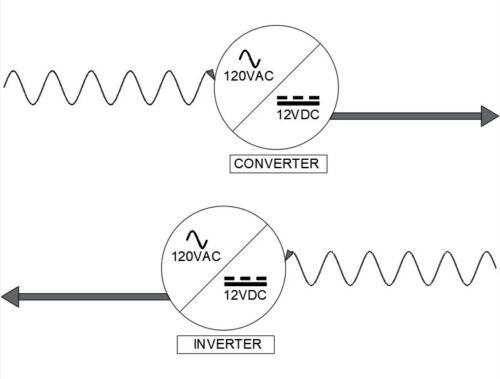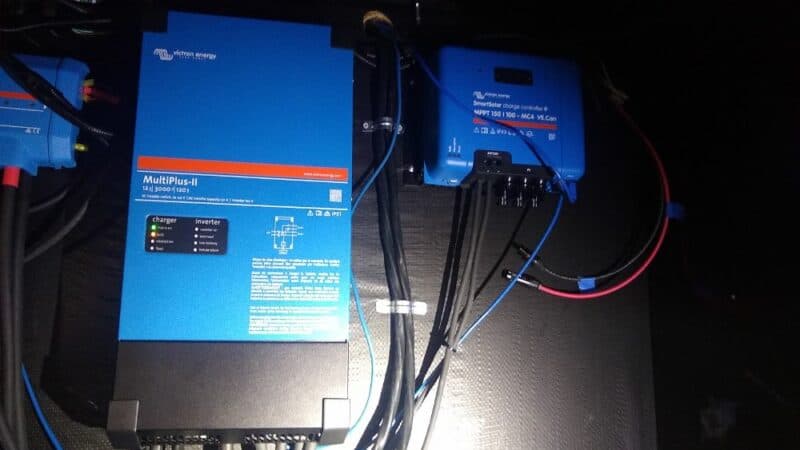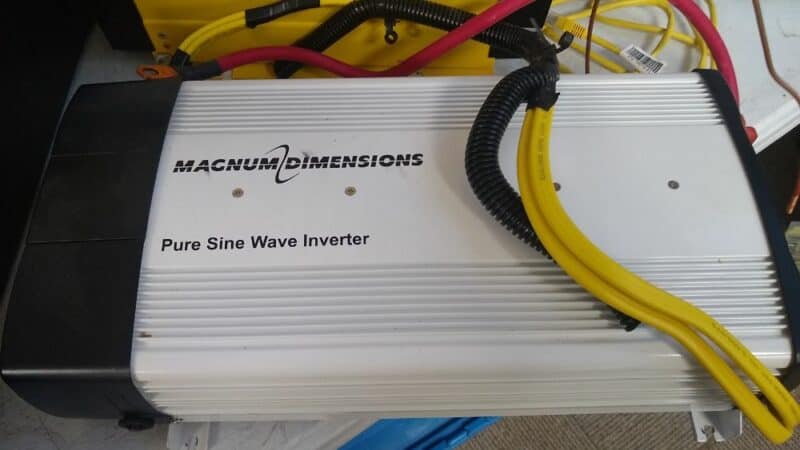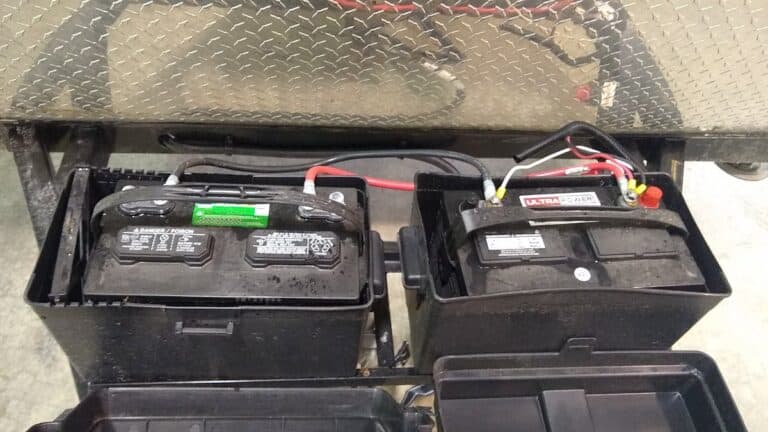Let’s talk sorcery. Er, electricity. (Sorry, lots of people get the two mixed up).
Actually, let’s talk about one specific electrical component: the inverter. You may or may not have one in your RV. By the end of this article, you’ll wish you did.
(Before You Begin)
If you’re a seasoned RVer, you can skip this appetizer and scroll straight to the entrée. If your knowledge of RV electrical systems consists of that-thingy-plugs-into-that-thingy-and-the-lights-turn on, then keep reading.
Your RV has two electrical systems delivering two “types” of power.
- Low-voltage direct-current power from your battery or alternator (12VDC)
- And medium-voltage alternating current from shore power or inverter (120VAC* or 240VAC).
Most of your loads and appliances can only run off one type of power.
- Your lights, socket outlets, ceiling fans and other small items run directly off 12-volt DC power.
- Meanwhile, your energy-hungry appliances, such as your air conditioner and microwave, require 120-volt AC power.
You’ve probably spotted the major flaw with this system. If you like to camp off-grid, you don’t have access to shore power! So you can’t run your air conditioner or microwave without a loud, smelly generator.
– or an inverter! (Enter, this article).*
*You may see this referred to as 125-volt, 115-volt, or even 110-volt power. For all purposes, they all mean the same source.
**Please, don’t confuse an “inverter” with an “inverter generator.” They are two completely different things!
What Is an RV Inverter?

Your inverter allows you to run your “shore power” appliances off your house batteries. In other words, you could run your air conditioner off your battery! (Don’t shout for joy and install the nearest inverter just yet, though).
To get a little technical, an inverter inverts electricity from direct current (DC) to alternating current (AC).
In the case of an RV, an inverter transforms 12-volt direct-current electricity from your house batteries (or your alternator, if you have a motorhome) into 120-volt alternating current electricity for your big appliances: air conditioner, microwave, electric oven, etc.
This Is An Inverter
So, this is an inverter (the blue one that says MultiPlus-II):

… but so is this one!

Confused? Essentially, bigger inverters can deliver more power.
There are even really, really small portable inverter can be plugged into a 12V socket outlet. We won’t be talking about those, though. They only deliver enough power to charge a laptop or run a small desktop fan.
Hey, Don’t I Already Have a Converter?
No, I said INVERTER! But don’t feel bad. The two are commonly confused.
A converter does the opposite of an inverter: It converts AC power to DC power. So when you plug into shore power, your converter transforms some of the 120VAC power to 12VDC power to charge your house batteries.
Just about every RV has a converter because one is required for basic operation. But many don’t have an inverter, because they are an optional feature.
But What About Inverter Chargers?
Hey, don’t blame me. I didn’t come up with all the confusing names.
Some people use the word “inverter” as a shorthand name for “inverter charger,” which is essentially an inverter PLUS a converter, all rolled into one! You’ll often see them described as an inverter + battery charger.
(If you must know, a battery charger of any sort is just a microprocessor-controlled converter optimized for charging batteries, not for powering constant loads).
We will address why you might want an inverter charger later in this article.

Do I Need an RV Inverter?
So, now that you know what an inverter is, do you need one?
Let’s take a short quiz. Do any of the following apply to you?
- Enjoy camping off-grid for 3 days or more?
- Want to power your 120-volt appliances without running your generator?
- Run your rig off of solar power?
- Use sensitive microprocessor-controlled electronics?
Then chances are, yes, you need an inverter! Let’s run through each of these scenarios.
A. Camping Off-Grid
When you’re camping off the grid, you don’t have shore power. You’re on your own.
Now, let’s suppose that you have a gas generator to run your air conditioner in the evening. All well and good. But what about when you need to charge your laptop battery at 8:30 a.m.? Do you really want to turn on your generator just to juice up your Dell?
An inverter is perfect for running small 120V appliances, like computers, electric blankets, gaming consoles, box fans, etc.
Without an inverter, you’re forced to start up the generator to power any of these loads, no matter how small they are.
B. Power Your Air Conditioner WITHOUT Using Your Generator
Most boondocking RVers use a generator to power up their air conditioners and other large AC appliances.
Unfortunately, this comes along with several problems.
- You have to leave your generator running all the time, even if your air conditioner is cycling on and off!
- Conventional open-frame generators are extremely loud and annoying.
- Modern inverter generators are fuel-efficient and quiet, but quite expensive.
With an electrical inverter, you can bid farewell to noise, toxic fumes, gasoline spills, strained backs, glaring neighbors, and people intentionally letting their dogs poop in your campsite.
C. Run Your Rig Off of Solar Power
A solar panel system puts energy juice into your batteries. But how do you get it out? If you want to power anything besides your lights, ceiling fans and other small items, then you must use an inverter!
The size of your inverter should be similar to the DC rating of your solar panels. So if you are installing a 1000 watt system (5 x 200-watt panels), you should purchase an inverter of at least 1000 watts.
D. Use Sensitive Electronics
Do you run audiovisual equipment, like digital cameras or audio equipment? Do you travel using medical-grade equipment, like a CPAP?
Then you need an inverter! You don’t want to supply these devices with “dirty” unfiltered power from a conventional generator.* You need an inverter.
*Some premium inverter generators, like a Honda or Yamaha, filter and clean their power before delivery.
Do I Need a Pure Sine Wave Inverter?
Fair warning: This section gets a little technical.

TLDR: Get a pure sine wave inverter. Otherwise, at least get a high-quality modified sine wave inverter. Spend as much money as you can afford, because the extra price directly correlates to improved quality.
We’re not going to dive deep into how to understand and interpret an AC voltage waveform. For that, I invite you to visit this page at Electronics Tutorials.
In the perfect world, AC electricity looks like this, a perfect sinusoid:

All you need to understand is that no inverter delivers that perfect sinusoidal shape. And when electricity isn’t perfect, appliances can overheat, short-circuit, or otherwise fail.
That’s why you can purchase three types of inverters:
- Pure sine wave
- Modified sine wave
- Square wave
Pure Sine Wave Inverter
A pure sine wave inverter tries to deliver a “perfect” AC voltage waveform. It will match (or even exceed) the quality of electricity from your house wall outlets.
Pure sine wave inverters offer many advantages:
- Easier motor starting.
- Full power operation.
- Higher efficiency.
- Less waste heat.
- Quieter, more fluid operation. No buzzing.
- Reduced interference in audio or electronic equipment.
- Less stress on the surge protection circuitry.
- Longer appliance lifespan.
As a rule of thumb, the more complex the equipment, the better it will run on pure sine wave power. This includes ambient light dimmers, audiovisual equipment, battery chargers, microwaves, compressor refrigerators, and just about anything with a modern motor.
Modified Sine Wave Inverter
Modified sine wave inverters deliver a stepped voltage waveform. These are the most common types of inverters.
Most appliances WILL operate off a modified sine wave inverter. Only a few devices, such as medical-grade equipment and sensitive audiovisual equipment, require true pure sine waves.
However, you’ll face some compromises.
- Most motor-driven appliances (fans, pumps, air conditioners) will use about 20 percent more power. So they aren’t nearly as efficient, and you’ll drain your battery faster.
- Fluorescent lights may hum or buzz.
- Digital clocks, timers, and electronic temperature controls may not run at all or run incorrectly.
Square Wave Inverter
A square wave inverter is the absolute cheapest. Quite frankly, almost no one makes them anywhere, and you won’t find them sold at your local RV dealership or elsewhere.
But if you’re purchasing an inverter that’s been locked away in someone’s closet for 10 years, make sure it’s not a square wave inverter!
If it is, chuck it in the trash. They aren’t good for anything except simple tools with universal motors. And even then, they’ll shorten the lifespan of the tool.
How to Correctly Choose Inverter Size?
When shopping for an inverter, you need to consider the wattage rating.
Inverters are sold with two wattage ratings:
- Continuous: How much power can be delivered continuously.
- Surge: How much power can be delivered for up to a second or so.
How do you choose the correct wattage rating?
Now, you could dissect your RV electrical system, calculate your average and maximum wattage requirements by appliance and hour, and then spend three hours researching inverters. And then make your choice. And then spend another hour second-guessing yourself.
Or you could do it the easy way, and keep reading.
*Note: All ratings below are for continuous wattage ratings!
Power for On-the-Go Electronics (300-700 watts)
The minimum useful size is about 300 watts. These inverters may be available as portable plug-in inverters, which plug into DC socket “cigarette lighter” outlets.
These aren’t worth much. At most, they can power one outlet. Usually, these are sold as portable inverters that plug into a DC socket outlet. Be aware that not all DC socket outlets can output the same amount of power. Some are rated for 10DC amps, some 20, and some 30. So you may blow a fuse if you try to draw too much power.
Power for Small AC Appliances (700 – 1400 watts)
Anything smaller than 1000 watts is only suited for computers, tablets, battery charging, etc. No appliances. If you want to run smaller appliances, such as a 700-watt microwave or an AC/DC 2-way refrigerator, the smallest recommended inverter size is 1000 watts.
However, you can only run one appliance at a time! And you probably can’t run your rooftop air conditioner. And you also probably can’t power any other appliance that creates heat, like a coffee maker, hair dryer, etc.
Power for All-Around Appliances (1400 – 3000 watts)
Want to run your coffee maker in the morning? Interested in running a small space heater? Then you need a medium-sized inverter capable of at least 1400 watts (for reference, a 15-amp circuit at full load will draw 1800 watts).
These are a very common size in RVs. They are often hardwired from the factory, where they run a special outlet circuit and maybe one or two other appliances, like your refrigerator.
Power for the Big Time (3000-5000+ watts)
If you have exceptional power needs – say, you’re a contractor with portable power tools, or you plan to run multiple air conditioners at once – then you’ll need a big honkin’ expensive inverter capable of 2400 watts or more!
Most inverter product lines top out at 3000 watts. You’ll have to search hard to find an inverter rated for more. Xantrex offers 3000W and 5000W inverters in their XPower series. Victron offers MultiPlus and Quattro inverters that can be paired in parallel for as much power as you need!
Be aware that the larger the inverter,
- The bigger the physical size
- The more expensive
- The power it will consume while idle
What Are the Best RV Inverter Brands?
You know what I hate?
I hate when you search for “Best RV Inverter” on Google, and you know what pops up? A bunch of digital storefronts all posing for whatever product is selling on Amazon!
What’s below is a REAL list.
I’ve either used these products, spoken with company representatives, or I’ve had them recommended by full-time RVers and industry professionals I trust.
- Xantrex
- AIMS Power
- GoPower
- Renogy
- Magnum
- Samlex
These are all quality manufacturers. You can take their products to the bank.
(A Cautionary Word on Battery Bank Size)
So, I’ve been keeping a secret from you…
I haven’t talked about batteries. I’ve let you believe that you can just throw a 2000W inverter on any old battery. But you can’t. Not unless you want to ruin your batteries in short order.
As a rule, your inverter can only be 3-5x the amp-hour capacity of your battery bank.
So if you have a single 100-Ah battery, the largest inverter you should purchase is 500 watts. And that’s pushing it.
And since we’ve just learned that you really need at least 1,500 watts to run medium-sized AC appliances, that means you need at least 300-Ah in your battery bank. Which means you probably need 3+ batteries.
If you want to run your air conditioner off a 2500W inverter, you need at least 500-Ah of capacity! And that’s the bare minimum! 1,000-Ah would be much, much more practical.
But that’s several hundred pounds of lead-acid batteries. If you own a motorhome or luxury fifth wheel, you can find room in your “basement” for all those batteries. But if you own a conventional travel trailer, you can’t put all those batteries on the tongue (for many reasons). You’ll have to get creative.
Anyways, that’s my secret. Your inverter is only as strong as your battery system.

Top 5 Things to Know About Installing an RV Inverter
Look, I don’t know what inverter you own. You’ll have to read your own Owner’s Manual. But I’ll bet money that you’ll need to pay attention to the following 5 rules.
- Inverters belong somewhere dry, clean, cool, and ventilated. I don’t mean ventilated to the outdoors – just that the hot air needs to be exchanged. And don’t install the inverter in the same compartment as the batteries if you can help it.
- Orientation matters. Some inverters can be installed on vertical surfaces or upside down; others cannot. Check your Owner’s Manual.
- You’re going to need some big (and I mean BIG) wire for the DC connections. Common recommended sizes range from #6 to #4/0. You’ll need to stop by your local building supply store and purchase it by the foot. This size of wire requires special tools most DIYers don’t own.
- Keep the wires from the battery bank SHORT! Anything more than 6 foot can cause severe voltage loss.
- You’ll need an inline fuse on the positive wire (hot) close to the battery terminal as over-current and short-circuit protection for the inverter.
A Dive Into Inverter Specifications
Confused about RV inverter specifications? Feel like you’re reading Yiddish?
Let’s take a look at the Xantrex Prosine 1000 RV inverter. And let’s work through all the major specifications. By the end, you’ll be an expert!

Output Power
This is how much power, measured in watts, that the inverter can continuously output without overheating.
Surge Rating
The surge rating is how much power, measured in watts, that the inverter can output for a few seconds to start up inductive loads, such as air conditioners and microwaves. The surge may last for a few milliseconds up to 2-3 seconds.
Output Current (Peak)
This is a little … confusing. This DOES not mean the inverter can output 25 amps of continuous power!
Let’s work through the math a little bit.
If we apply Watt’s law, then at 120 volts and 1000 watts, the inverter can only supply 8.3 amps continuously. And that’s precisely the number we find in the Owner’s Manual for the Continuous AC Output Current Rating.
To supply peak amps (25 amps) at maximum surge wattage (1500 watts), the inverter would have to lower the voltage to just 100 volts!
Most EMS surge protectors will shut off power supply at 102-104 volts because many appliances are only for operation down to 108 volts or so.
Confused yet? Essentially, you can ignore this number. The number you care about is the Continuous AC Output Current Rating.
Output Voltage (No Load)
When no loads are connected to the inverter, what’s the RMS voltage range?
Output Voltage (Over Full Load)
An inverter attempts to output a steady voltage regardless of the load size or the state of charge of the battery. This number tells you the voltage range you should expect to see.
Generally, staying between 108 and 125 volts is safe for your appliances.
Output Frequency
Nominal frequency should be 60 Hz. Generally, +/- one- two two- Hertz is acceptable for most appliances.
Output Waveform
What type of voltage waveform is outputted? In this case, the ProSine 1000 is designed to output a “pure sine” waveform.
Unfortunately, achieving that perfect waveform is extremely difficult.
Actual waveforms are bit more, well, squiggly. These deviations can cause problems with harmonic distortion, peak-to-peak voltages, RMS values, etc.
Power supply subject to lots of deviations and distortions is called “dirty” power.
In this case, Xantrex says the PureSine maintains a sinusoidal waveform with very little harmonic distortion (less than 1% typical, 3% max). That’s excellent!
Peak Efficiency
All inverters lose some power.
- 90% or Above Excellent!
- 80-90% Good
- 70-80% Acceptable
- 60-70% Poor
- Below 60% Unacceptable
No Load Power Draw (Search Mode)
Huh? What’s Search Mode? Well, as you probably know, almost all electrical devices draw some amount of power even when they’re turned off.
Xantrex designed the ProSine with a super-low-power Search mode that conserves power. “The unit will remain in POWERSAVE mode if the load it detects is less than 10 W for the 1000 model,” says the company. In Search/PowerSave mode, the inverter only draws 1.5 watts, less than an LED light bulb!
No Load Power Draw (Idle Mode)
When the inverter has no connected load but is still ON (and not in Search mode), then the unit will draw approximately 20 watts. That’s 10x more than Search Mode!
20W may not sound like much, but it’s about as much as a netbook or tablet. Over the length of a weekend, that much idle power draw could significantly reduce your battery state of charge (hence why the inverter has a POWERSAVE mode).
Input Voltage Range
You can’t just connect an inverter to any ol’ battery setup. In this case, the Xantrex ProSine RV inverter is designed for connection to either a 12V or 24V system – not both! Just one. Different models sold, you see.
Example: Whether you have two 6V batteries wired in series or two 12V batteries wired in parallel makes no difference. So long as the system voltage is 12V (or 24V), the inverter will operate as designed.
The input voltage range should be compared to your battery state of charge. In this case, since most 12V batteries range between 10.5 and 14.1 volts, the Xantrex allow input range of 10-16 volts is more than sufficient.
Transfer Relay Rating
Many inverters – and this is one of them – come with a relay switch. Think of it like a gatekeeper. It only allows one source of input power into an RV.
For instance, what if you switch from inverter power to shore power? Or to a generator? What’s to stop the generator power from backfeeding into the inverter and wreaking havoc?
The transfer switch, that’s what!
Leave a Reply